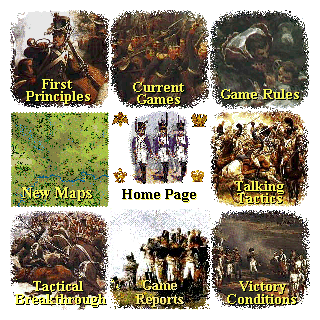|
|
|
The Idea
 Two players or groups take any
historical scenario and, preferably using the game maps, draw up their own troops'
dispositions. The background to the battle and availability of any reinforcements would
remain the same, but each commander can lay out his forces and influence where
reinforcements arrive according to his own ideas.
Two players or groups take any
historical scenario and, preferably using the game maps, draw up their own troops'
dispositions. The background to the battle and availability of any reinforcements would
remain the same, but each commander can lay out his forces and influence where
reinforcements arrive according to his own ideas.
Players will not only have access
to new versions of historical scenarios, they will have versions they can influence from
the start and make plans for according to their own dispositions. The resulting new
scenarios can be made available for anyone to use, adding to the catalogue of variations.
You will have the challenge of a realistic situation in which
all you know of the enemy's positions is what you can see. Your opponent will be
in the same situation and tactical skills will count for more than knowledge of
the game because each scenario is unique.
How it works
A third member will construct the scenario according to the above plans and act as umpire for the game. An army in a defensive posture will deploy its infantry, artillery and heavy cavalry first, plus any outlying skirmishers or scouting cavalry; any visible troops will be shown on the other player's map for him to take account of in his deployment. The attacker's scouting cavalry would go on the map first, possibly revealing more but committing the unit(s) to that role until recalled. Light cavalry, excluding those used in scouting, can deploy last, defender's and attacker's, to reflect their greater mobility. Any reinforcements can be asked to divert to a particular entry point in accordance with what their commander now knows, but the chance of them changing from their original route will be variable. To clarify the sequence:
In scenarios representing encounter actions the sequence will be simpler and more even:
Some kriegspiel of encounters between scouts and units deployed in areas overlapping from both sides might need to be undertaken, or the scenario can be started at the point where such a minor conflict occurs with the main forces still deploying. This will be very much up to the umpire.
Who makes it work
Anyone with the scenario editor can act as umpire for the set-up. I shall enter below the names of anyone willing to help in this respect, along with players wanting to take part in such a game. What is needed at first, I think, is a trio to run through the sequence of setting up a game, hopefully resulting in a playable scenario that can be continued. Put a note on the notice board if you want your name added to the list, in what capacity and your preferred original scenario.
Scenario |
Variation name |
Umpire/setup by |
Player/group side 1 |
Player/group side 2 |